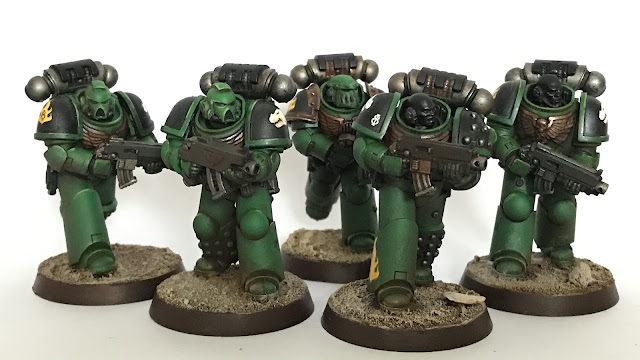+ Salamanders 2nd Company markings +
+ Work in progress – it seems a long time since I've been putting paint onto models, but it was a welcome return. +
+++
+ 8th Squad, 2nd Company +
+ As you can (hopefully!) see, the models are getting close to being finished. It's been a very different set of techniques to my usual process. Not sure I'd do everything this way, but it's nice to expand my repertoire. +
+ Although it's been a long time since I started them, the actual painting process has taken very little time indeed – though as always, the devil's in the details, so I won't make any promises on when the final touches will be in. +
+++
+ Combat squad 1 +
+++
+ 4th Squad, 2nd Company; and Lieutenant +
+++
+ Markings +
+ The Salamanders' lore is not always entirely clear. Always a bit more nebulous than other First Founding Chapters, what little there was has been partially overwritten by info from Nick Kyme's Black Library books, which itself has only been partly incorporated into the GW books. This is nothing new – nor is it a problem. While there's some security to be drawn from following a clear set of rules in terms of markings, such rules are always subject to the vagaries of time and chance – what was de facto correct in previous editions can easily be swept away. For that reason, I prefer to regard GW's info on markings as 'correct for a point in time', rather than immutable law. That allows you to nod to existing rules (great if your group lean more towards canonicity and pseudohistorial gaming) while also giving you a bit of freedom of expression. +
+ Ultimately, the lore can change, and your models will likely outlast it! FOr that reason, if nothing else, never compromise on making and painting your models to suit your taste first and foremost. +
+++
+ The vagaries of the Salamanders' background does extend to its markings, but as of the 8th edition Codex supplement, there is at least a big block of info, though a deep dive reveals a few awkward gaps. Despite having quite an unusual structure (seven companies of 120 or so marines each) and a number of practices that are decidedly non-Codex, it's sometimes referred to as a Codex Chapter – although perhaps this is an out-of-universe misunderstanding of the Codex Astartes. +
+ The Codex Astartes is essentially a 40k version of The Art of War – not the rigid list of strictures and dictates in which it's portrayed in memes, but rather an expansive and open treatise that has multiple interpretations. In this way, then, the markings we see below can be seen either as very idiosyncratic to the Chapter – and perhaps providing inspiration to their (thin on the ground) successors; or can be seen as a very clear example of Codex-approved markings. The iconography of the Salamanders, therefore, is very much an example of how you wish to interpret it – and this is what I mean by correct for a point in time. There are a couple of slightly contradictory statements in GW publications about the Salamanders' organisation, but we can square that circle by picking one and saying that this is the one that's true during the Second Battle for Armageddon. +
+ Basics +
+ In terms of the nuts and bolts of the markings, the squad markings are shown above. These show the eternal flame and the squad number or sigil enclosed in the flame. From left to right above is a marine of the 4th Squad, Second Company; a Lieutenant of the Second Company; and a marine of the 8th Squad, Second Company. +
+ Here we see the deviation from the Ultramarines' Codex structure, as the 8th squad in a Battle Company would usually be a designated Assault Squad. For the Salamanders, it's another Tactical Squad. +
+ Variation +
+ When working on an army, you'll often find some models that – for one reason or another – just don't work with the decisions you've made. Happily, 40k background often owes as much to mediaeval pageantry as modern military strictures, so you can happily play it by ear. Try to ignore the nagging voice that says 'this marking should be in this place' and picture yourself being attacked by the model – does what you see announce your attacker as belonging to a particular group? If so, job done. +
+ You can be as consistent or varied as you like. Personally I like consistency in a Chapters like Ultramarines, but for the Salamanders, who have a proud tradition of making their own personal wargear and armour, there's a good argument for variation for variations sake. +
+ Here, this sergeant has a studded left pauldron, leaving no space for the Chapter icon. As a result, it's been moved to the right pauldron, booting the eternal flame symbol to the lower right greave – my thinking being that this allows friendly forces to still identify who the marine is. +
+ Since the squad number would often be unclear, I kept it on the pauldron – you can just see a small white numeral at the front of the pauldron. This is a good example of making a virtue of seemingly contradictory information, for this approach is that presented in the Badab War Imperial Armour books. +
+ This in turn offers a nice narrative twist – we might say that this marine is a veteran of the Badab War campaign, recently promoted to lead his own squad; and granted leave to retain a previous campaign's iconography as a mark of respect to fallen brethren. The Codex, after all, suggests changing markings between conflicts to confuse the enemy... and so it all ties off nicely. +
+++










No comments:
Post a Comment
+ submission exloadform: inload [comments] herein +